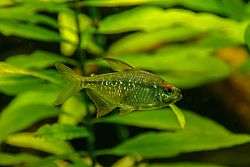Diamond tetra
The diamond tetra (Moenkhausia pittieri) is a small freshwater fish of the characin family (family Characidae) of order Characiformes. It is found in and around Lake Valencia in Venezuela, South America. This species exhibits clear sexual dimorphism, with males having much longer dorsal fins than the females. Males also tend to be more brightly coloured, but both sexes are attractive fish and have become popular with aquarists. The dorsal and anal fins are purple and the body is silver. The eye is marked with red above the pupil, and there is a dark band running along the midline of the body. Their common name comes from the bright, iridescent scales along the flanks.
| Diamond tetra | |
|---|---|
 | |
| Scientific classification | |
| Kingdom: | |
| Phylum: | |
| Class: | |
| Order: | |
| Family: | |
| Genus: | |
| Species: | M. pittieri |
| Binomial name | |
| Moenkhausia pittieri C. H. Eigenmann, 1920 | |
Habitat
The fish are endemic to the Northern area of Venezuela in The state of Carabobo. They are originally from the waters of the lake of Valencia an its tributaries. Here they live in slow moving streams with abundant vegetation and leaf litter. These fish today are threatened by the urban growth happening in Valencia, which destroys and pollutes the habitat of this fish. It seems like they have disappeared completely from the Lake of Valencia where they were collected for the first time. The Venezuelan underwater photographer in 2009 was able to find and photograph a population of this fish in a stream nearby the lake of Valencia.
In the aquarium
Nutrition
The diamond tetra is an omnivore. In the wild they will eat whatever they can get, with a preference for animal food, especially Mosquito larvae. In an aquarium they will eat most normal fish foods including flakes. They benefit from a variety of food such as live daphnia or frozen bloodworms.
Aquarium breeding
A pair of diamond tetras will spawn in an aquarium with an area well planted including fine leaved plants creating a well shaded area. The pair should be well conditioned before hand with rich food including live food.
The tank should be darkened before and during breeding, and then the light should slowly be increased over a few days to create a natural lighting.
The water should be very soft and a pH of 6 is preferable. A temperature of 28 degrees C (79 degrees F) is suitable.
The fish usually spawn in the early morning. They will eat their eggs and are normally removed after spawning. The eggs normally hatch in 36 hours and the fry are usually free swimming in 4 days.
The babies grow quickly. They will eat fry foods, but suitable sized live foods will help at all stages.
References
- http://aquatic-experts.com/ARTICLE_First_Ever_Photos_of_Diamond_Tetras_in_their_natural_habitat.html
- http://aquatic-experts.com/Moenkhausia_pittieri.html
- Froese, Rainer and Pauly, Daniel, eds. (2007). "Moenkhausia pittieri" in FishBase. January 2007 version.
- "Moenkhausia pittieri". Integrated Taxonomic Information System. Retrieved January 29, 2007.
- Riehl R. & Baensch H: Aquarium Atlas (vol. 1), Voyageur Press, 1996, ISBN 3-88244-050-3
- https://web.archive.org/web/20110120185420/http://www.bettatrading.com.au/Diamond-Tetra-Fact-Sheet.php
- https://mikolji.com/article/diamond-tetras-moenkhausia-pittieri-wild